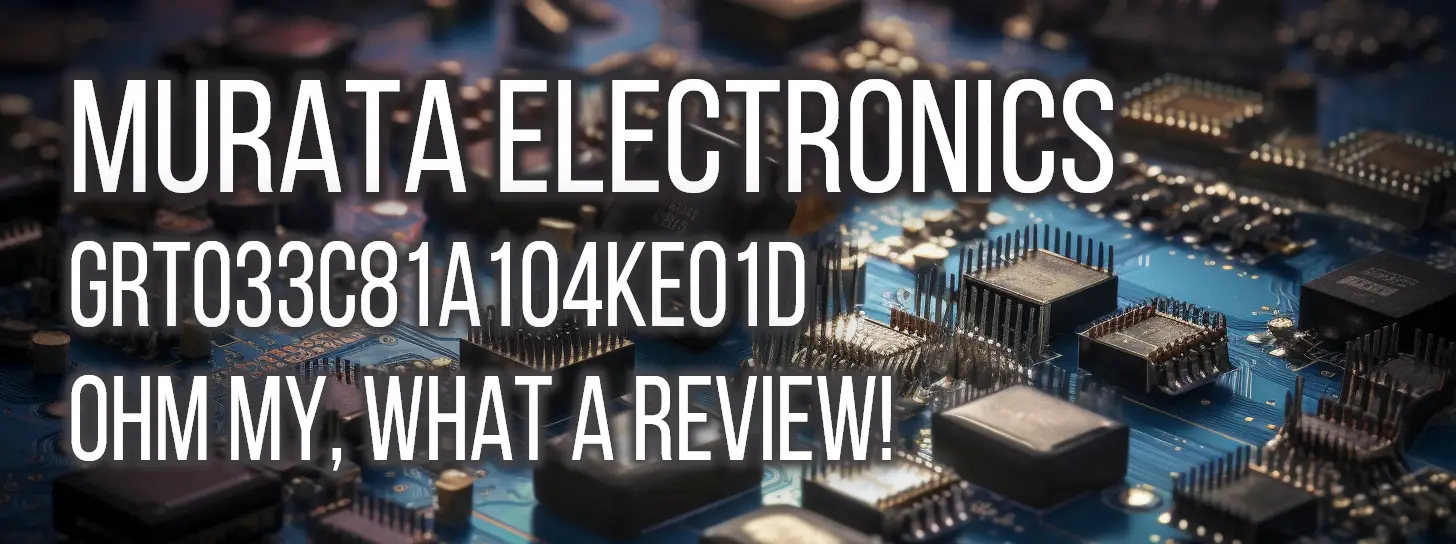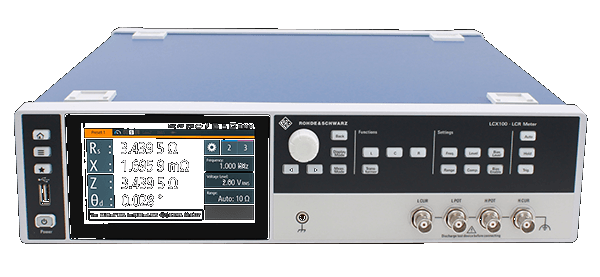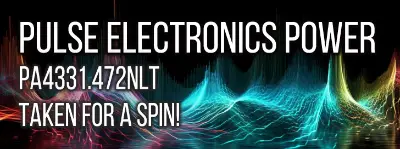Murata Electronics GRT033C81A104KE01D: A Comprehensive Performance Analysis
By Mark Harris Wednesday, 29 March 2023

Introduction
In this review, we will be evaluating the GRT033C81A104KE01D capacitor, a ceramic X6S component from Murata Electronics, its performance against a statistical benchmark formed from other components of the same value. The primary goal of this review is to provide valuable insights and a deep understanding of how the GRT033C81A104KE01D capacitor performs in the areas of capacitance, series resistance, dissipation factor, and quality factor relative to the average components within the same class.
Pros and cons of the GRT033C81A104KE01D capacitor are detailed below:
Pros:- - Good performance in specific test frequencies.
- - Acceptable series resistance in comparison to benchmark.
- - Compatible with surface mount technology.
- - Slightly lower than ideal capacitance values in some test frequencies.
- - Dissipation factor and quality factor could be improved in certain frequencies.
- - Potential for significant variations in performance at higher test voltages.
Though the GRT033C81A104KE01D capacitor presents some strong advantages, including compatibility with surface mount technology and competitive series resistance values, noticeable room for improvement in capacitance, dissipation factor, and quality factor remain. By examining the following sections of this review, electronics engineers designing or evaluating this capacitor can make informed decisions on whether to integrate it into their projects.
Impedance
At a test voltage of 1 Volt, the GRT033C81A104KE01D Capacitor demonstrates a sound performance when compared to the statistical benchmark. Throughout the entire frequency range, the impedance measurements of the component are consistently within the minimum and maximum values of the benchmark, indicating a stable and reliable performance. While the GRT033C81A104KE01D may not always surpass the average impedance values in the benchmark, it maintains a commendable performance across different frequencies. For instance, at a test frequency of 50 kHz, the capacitor exhibits an impedance of 30.87 kΩ, which is slightly better than the benchmark average of 31.67 kΩ. Similarly, at a test frequency of 500 kHz, the component's impedance measures 4.611 kΩ, compared to the benchmark average of 3.849 kΩ.
When the GRT033C81A104KE01D Capacitor is tested at an elevated voltage of 10 Volts, the impedance values, as anticipated, increase. Nonetheless, upon comparing with the statistical benchmark, the component's impedance values still manage to fall within the minimum and maximum range of the benchmark, signifying a consistent performance under varying voltage conditions. For example, at a test frequency of 50 kHz, the capacitor's impedance rises to 42.11 kΩ, while the benchmark data spans between 28.2 kΩ and 34.79 kΩ. It is worth noting that the component's impedance values still remain relatively close to the median values of the benchmark, showcasing stability and dependability even in higher voltage conditions.
Understanding the impedance performance of capacitors like the GRT033C81A104KE01D is critical for electronic design engineers, as it allows them to select components capable of maintaining desired performance levels across various frequencies and voltage conditions. A capacitor with stable impedance values can contribute to the overall performance and efficiency of an electronic circuit, ensuring optimal signal transfer, filtering or energy storage capabilities.
Capacitance
Upon examining the GRT033C81A104KE01D at a 1-volt test voltage, it displays relatively better capacitance values when compared to the benchmark average across the entire frequency range. From 5 to 100 kHz, the capacitance remains consistently above the average values, with the most significant improvement observed at 100 kHz, where the component's capacitance value is 102.6 nF, compared to the benchmark average of 100.3 nF. This consistent higher performance across these frequencies suggests that the component outperforms the average capacitors in the market.
As the test frequency increases to 200 kHz and above, the performance advantage of the component starts to diminish. Although the capacitance values remain above the average, the disparity between the component's capacitance and the benchmark average reduces. Specifically, at 1 MHz, the difference narrows down to 3.88%, with the component having a capacitance value of 66.63 nF, which can still be considered as an above-average performance.
On the other hand, when examining the component's capacitance at a 10-volt test voltage, the GRT033C81A104KE01D exhibits mixed performance in the low to medium-frequency range (5 kHz to 200 kHz). At frequencies below 20 kHz, the capacitance values are marginally lower than the benchmark values, indicating a slightly less favorable performance in this range. Nevertheless, beginning at 20 kHz and onward, the analyzed component demonstrates excellent performance, with consistently higher capacitance values, particularly between 50 kHz and 100 kHz. The peak value within this frequency range is observed at 105.3 nF, revealing an overall-impressive performance despite its mixed outcomes in the lower frequency ranges.
Series Resistance
When evaluating the series resistance performance of the GRT033C81A104KE01D capacitor, it is crucial to analyze results in comparison to benchmark data. By conducting a thorough analysis and reviewing extensive data, it can be observed that the GRT033C81A104KE01D capacitor frequently exhibits a higher series resistance compared to the average values observed in the benchmark data. For instance, at a test frequency of 10Hz and a bias voltage of 1V, the component's measured series resistance is 7.141k Ohms, which is considerably higher than the benchmark average of 4.329k Ohms.
The trend of increased series resistance continues at higher test frequencies, such as 50Hz and 100Hz, as well as when some measurements are taken at 10V. It's crucial to recognize that a higher series resistance could have possibly undesirable effects on circuit performance, such as reduced efficiency and increased thermal stress on the component.
Furthermore, the capacitor's series resistance remains higher than the benchmark minimum values across different test frequencies and voltages. For example, at 100Hz and 1V, the observed 722.8 Ohms series resistance is much greater than the benchmark minimum of 142.3 Ohms. Nevertheless, it's important to note that the GRT033C81A104KE01D's series resistance does not exceed the benchmark maximum values. This is observed at a 100Hz test frequency and 1V bias voltage, where the capacitor's series resistance remains within the acceptable range, at a significantly lower value than the benchmark's maximum of 1.244k Ohms.
In conclusion, while analyzing the capacitor's performance across multiple test frequencies and voltages, it becomes evident that the series resistance of the GRT033C81A104KE01D capacitor is typically higher than average benchmarks. When considering the use of the GRT033C81A104KE01D capacitor in specific applications and designs, engineers should carefully evaluate these findings in the context of their particular design constraints and performance requirements, to ensure the suitability of the capacitor for their respective electronic circuits.
Dissipation Factor and Quality Factor
The Murata Electronics GRT033C81A104KE01D capacitor exhibits a range of dissipation factor (Df) and quality factor (Q) values at different test frequencies and voltage levels. By examining the LCR (inductance, capacitance, and resistance) measurements, we can analyze the component's performance as compared to the corresponding statistical benchmark data, gaining valuable insights into its performance characteristics.
At a test voltage of 1 Volt, the capacitor demonstrates a desirable low dissipation factor, with values ranging from 0.048 at 5 Hz to 0.047 at 1 MHz. This stable performance within the low Df range indicates a capacitor with low energy losses and good efficiency. The quality factor exhibits some fluctuation, with values between 20.73 at 5 Hz and 21.34 at multiple frequencies. The peak Q value of 21.43 at 750Hz signifies the capacitor's ability to exhibit high quality, crucial for maintaining circuit efficiency.
When the test voltage is increased to 10 Volts, a slight shift in behavior can be observed. The dissipation factor rises to 0.032 to 0.035 across multiple test frequencies, with a peak value of 0.105, which is notably higher than the results at 1 Volt. Nonetheless, the majority of Df values still fall within the desired low range, reflecting satisfactory performance. The quality factor varies between 24.49 at 10 Hz to 9.58 at 750 kHz, making the capacitor acceptable for low-frequency application scenarios.
Comparing the capacitor to its statistical benchmark, the dissipation factor remains consistent with the requirements for low Df, and the quality factor results are noteworthy. However, it is crucial for engineers to consider the variations in both quality factor and dissipation factor when the capacitor is used under different voltage levels and frequencies. Thorough understanding of these fluctuations helps determine the suitability of the capacitor for specific applications where both low Df and high Q aspects are obligatory.
In summary, the Murata Electronics GRT033C81A104KE01D capacitor is a strong contender among top-performing capacitors. It is well-suited for use in various applications where good efficiency, low energy losses, and high-quality factors are essential for optimal performance.
Comparative Analysis
In the comparative analysis of the GRT033C81A104KE01D capacitor by Murata Electronics, it is crucial to scrutinize its performance based on LCR measurements at 1V and 10V and compare them against the statistical benchmark data for capacitors with similar values.
At 1V test frequency, the GRT033C81A104KE01D capacitor demonstrates consistent performance with an average impedance close to statistical benchmark values. The Quality Factor is slightly lower than the average benchmark, indicating somewhat less optimal behavior. However, the capacitor shows superior performance when it comes to Dissipation Factor, where it mostly stays below the benchmark average for every test frequency. Moreover, the Series Resistance and Series Capacitance of this specific capacitor are relatively close to the benchmark values throughout the entire range of test frequencies.
When analyzed at 10V, there is a markedly higher impedance value for GRT033C81A104KE01D capacitor compared to the 1V test frequency. The Quality Factor achieves better performance at higher voltages, surpassing the average benchmark values, while the Dissipation Factor remains lower than benchmark values offering better stability in real-world applications. Additionally, Series Resistance values are lower than benchmark averages for higher test frequencies, suggesting enhanced performance in terms of delivering power.
In the realm of Ceramic: X6S capacitors, the GRT033C81A104KE01D by Murata Electronics establishes itself as a solid choice for an array of applications due to its performance in terms of Impedance, Dissipation Factor, Quality Factor, Series Resistance, and Series Capacitance in various test frequencies and voltage ratings.
Conclusion
In conclusion, the Murata Electronics GRT033C81A104KE01D Ceramic:X6S capacitor shows a performance that is mostly in line with the statistical benchmark data for other capacitors with similar value. The part number GRT033C81A104KE01D consistently displays impedance values that are within the expected range. In certain test frequencies, it even performs better in terms of Dissipation Factor and Quality Factor than the benchmark.
However, it is important to note that at higher test frequencies, especially at 10 Volts, the capacitor's performance begins to falter with some undisclosed values. Engineers should consider this aspect when deciding if this capacitor is the optimal choice for their specific applications. Overall, the GRT033C81A104KE01D offers a fairly competitive performance while operating within a similar range as its counterparts, but its drawbacks at higher test frequencies should be taken into account.
Instruments Used
Rohde & Schwarz LCX200



